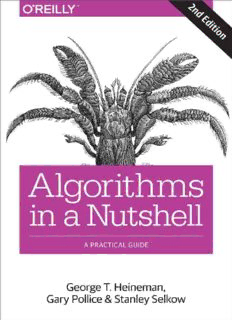
Algorithms in a Nutshell: A Practical Guide PDF
Preview Algorithms in a Nutshell: A Practical Guide
Algorithms in a Nutshell SECOND EDITION George T. Heineman, Gary Pollice & Stanley Selkow Algorithms in a Nutshell by George T. Heineman, Gary Pollice, and Stanley Selkow Copyright © 2016 George Heineman, Gary Pollice and Stanley Selkow. All rights reserved. Printed in the United States of America. Published by O’Reilly Media, Inc., 1005 Gravenstein Highway North, Sebastopol, CA 95472. O’Reilly books may be purchased for educational, business, or sales promotional use. Online editions are also available for most titles (http://safaribooksonline.com). For more information, contact our corporate/institutional sales department: 800-998-9938 or [email protected]. Editors: Andy Oram and Mary Treseler Production Editor: Colleen Lobner Copyeditor: Christina Edwards Proofreader: Jasmine Kwityn Indexer: Judy McConville Interior Designer: David Futato Cover Designer: Karen Montgomery Illustrator: Rebecca Demarest October 2008: First Edition March 2016: Second Edition Revision History for the Second Edition 2016-03-09: First Release See http://oreilly.com/catalog/errata.csp?isbn=9781491948927 for release details. Nutshell Handbook, the Nutshell Handbook logo, and the O’Reilly logo are registered trademarks of O’Reilly Media, Inc. Algorithms in a Nutshell, the cover image of a hermit crab, and related trade dress are trademarks of O’Reilly Media, Inc. While the publisher and the authors have used good faith efforts to ensure that the information and instructions contained in this work are accurate, the publisher and the authors disclaim all responsibility for errors or omissions, including without limitation responsibility for damages resulting from the use of or reliance on this work. Use of the information and instructions contained in this work is at your own risk. If any code samples or other technology this work contains or describes is subject to open source licenses or the intellectual property rights of others, it is your responsibility to ensure that your use thereof complies with such licenses and/or rights. 978-1-491-94892-7 [LSI] Preface to the Second Edition Revising a book for a new edition is always an arduous task. We wanted to make sure that we retained all the good qualities of the first edition, published in 2009, while fixing some of its shortcomings and adding additional material. We continue to follow the principles outlined in the first edition: Use real code, not just pseudocode to describe algorithms Separate the algorithm from the problem being solved Introduce just enough mathematics Support mathematical analysis empirically As we updated this second edition, we reduced the length of our text descriptions and simplified the layout to make room for new algorithms and additional material. We believe we continue to offer a Nutshell perspective on an important area of computer science that has significant impact on practical software systems. Changes to the Second Edition In updating this book for the second edition, we followed these principles: Select New Algorithms After the publication of the first edition, we often received comments such as “Why was Merge Sort left out?” or “Why didn’t you cover Fast Fourier Transform (FFT)?” It was impossible to satisfy all of these requests, but we were able to add the following algorithms: Fortune’s algorithm, to compute the Voronoi Diagram for a set of points (“Voronoi Diagram”) Merge Sort, for both internal memory data as well as external files (“Merge Sort”) Multithreaded Quicksort (“Parallel Algorithms”) AVL Balanced Binary Tree implementation (“Solution”) A new Spatial Algorithms chapter (Chapter 10) contains R-Trees and Quadtrees In total, the book covers nearly 40 essential algorithms. Streamline Presentation To make room for the new material, we revised nearly every aspect of the first edition. We simplified the template used to describe each algorithm and reduced the accompanying descriptions. Add Python Implementations Rather than reimplement existing algorithms in Python, we intentionally used Python to implement most of the new algorithms added. Manage Code Resources The code for the first edition was made available as a ZIP file. We have since transitioned to a GitHub repository. Over the years we improved the quality of the code and its documentation. We have incorporated a number of blog entries that were written after the publication of the first edition. There are over 500 unit test cases and we use code coverage tools to ensure coverage of 99% of our Java code. In total, the code repository consists of over 110 KLOC. Audience We intend this book to be your primary reference when seeking practical information on how to implement or use an algorithm. We cover a range of existing algorithms for solving a large number of problems and adhere to the following principles: When describing each algorithm, we use a stylized template to properly frame each discussion and explain the essential points of each algorithm We use a variety of languages to implement each algorithm (including C, C++, Java, and Python). In doing so, we make concrete the discussion of algorithms and speak using languages you are already familiar with We describe the expected performance of each algorithm and empirically provide evidence to support these claims We intend this book to be most useful to software practitioners, programmers, and designers. To meet your objectives, you need access to a quality resource that explains real solutions to practical algorithms you need to solve real problems. You already know how to program in a variety of programming languages. You know about the essential computer science data structures, such as arrays, linked lists, stacks, queues, hash tables, binary trees, and undirected and directed graphs. You don’t need to implement these data structures, since they are typically provided by code libraries. We expect you will use this book to learn about tried and tested solutions to solve problems efficiently. You will learn some advanced data structures and novel ways to apply standard data structures to improve the efficiency of algorithms. Your problem- solving abilities will improve when you see the key decision for each algorithm that make for efficient solutions.
Description: